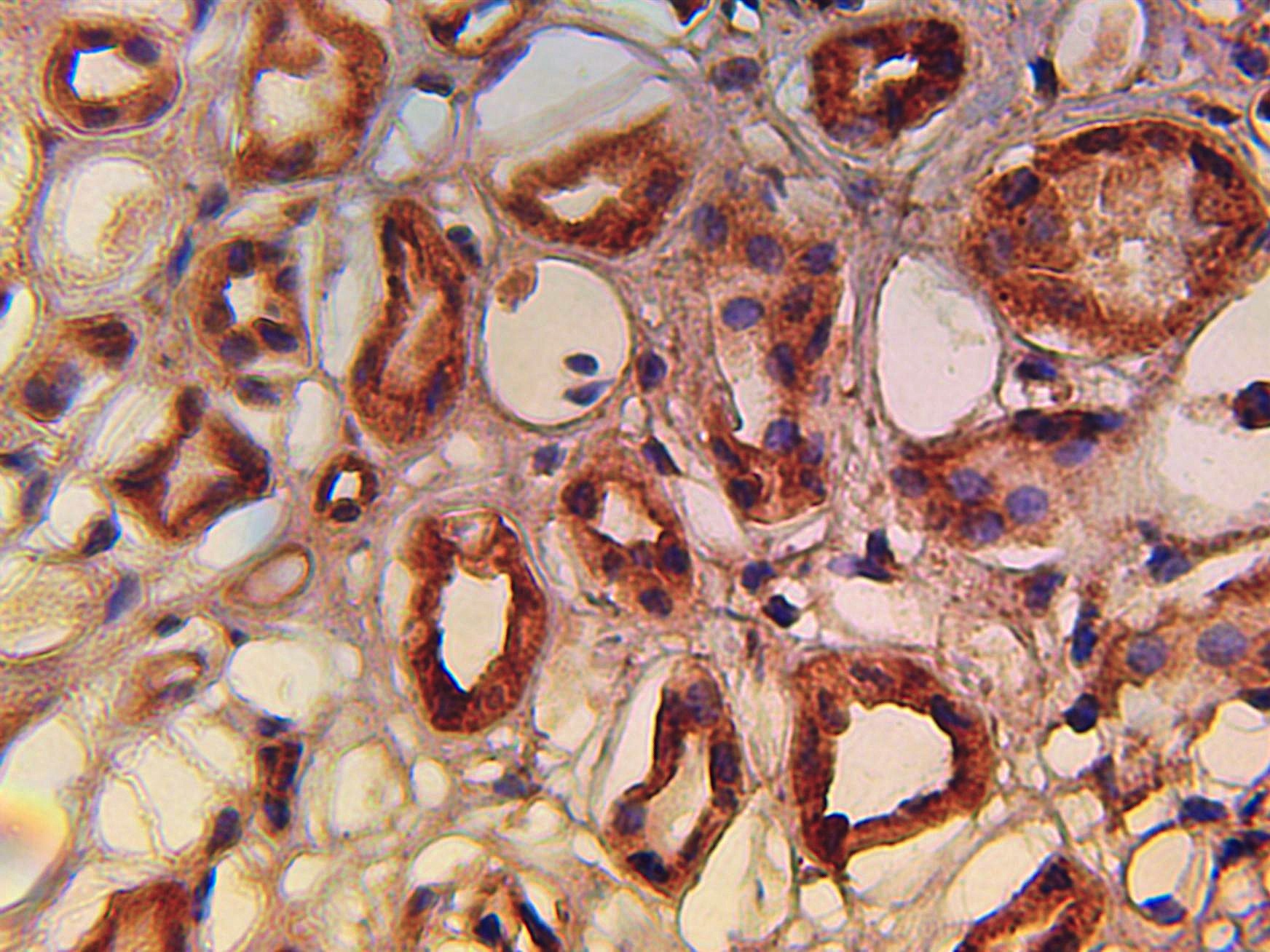Catalogue

Rabbit anti Human Sirt1 Protein (Human)
Catalog number: X2739P| Isotype | Ig |
| Product Type |
Antigen Immunoaffinity Purified Polyclonal |
| Units | 100 µg |
| Host | Rabbit |
| Species Reactivity |
Human |
| Application |
ELISA Immunohistochemistry Western Blotting |
Background
Sirtuin 1 (Sirt 1) is encoded by a gene that encodes a number of the sirtuin-like proteins, all homologs to the yeast Sir2 protein. Members of the sirtuin family are characterized by a sirtuin core domain. Yeast sirtuin proteins are known to regulate epigenetic gene silencing, suppress recombination of DNA and repressess rDNA transcription by the RNA pol. Studies suggest that the human sirtuins regulate apoptosis by impairing proapoptotic ability and modulating cell senescence. They regulate muscle differentiation by deacetylating key proteins. They also deacetylate the following: 'Lys-382' of p53/TP53, TAF1B, 'Lys-266' of SUV39H1 (leading to its activation), 'Lys-26' of HIST1H1E, APEX1 at 'Lys-6' and 'Lys-7' and 'Lys-16' of histone H4 (in vitro), as well as H2A. Sirtuins are also involved in HES1- and HEY2-mediated transcriptional repression and inhibit skeletal muscle differentiation by deacetylating PCAF and MYOD1. They may serve as a sensor of the cytosolic ratio of NAD+/NADH, which is essential in skeletal muscle cell differentiation. The eNoSC complex is able to sense the energy status of cell: upon glucose starvation, elevation of NAD+/NADP+ ratio activates SIRT1, leading to histone H3 deacetylation followed by dimethylation of H3 at 'Lys-9' (H3K9me2) by SUV39H1 and the formation of silent chromatin in the rDNA locus. In the case of HIV-1 infection, sirtuin interacts with and deacetylates the viral Tat protein. Cellular AP endonuclease activity is stimulated by promoting the association of APEX1 to XRCC1. Red wine, which contains resveratrol, may participate in activation of sirtuin proteins, and may therefore participate in an extended lifespan as observed in yeast.
Synonyms: NAD-dependent deacetylase sirtuin-1, hSIRT1, SIR2-like protein 1, hSIR2, SIRT1, SIR2L1
Source
Immunogen: Synthetic Peptide near C terminal of human Sirt 1
Product
Product Form: Affinity Purified
Formulation: Provided as solution in phosphate buffered saline with 0.08% sodium azide
Purification Method: Antigen Immunoaffinity Purification
Purity: >95 %
Concentration: See vial for concentration
Applications
Optimal concentration should be evaluated by serial dilutions.
Functional Analysis: IHC, Western Blotting, Direct ELISA
Positive Control: Widely expressed nuclear localization.
Storage
Product should be stored at -20°C. Aliquot to avoid freeze/thaw cycles
Product Stability: See expiration date on vial
Shipping Conditions: Ship at ambient temperature, freeze upon arrival
Caution
This product is intended FOR RESEARCH USE ONLY, and FOR TESTS IN VITRO, not for use in diagnostic or therapeutic procedures involving humans or animals. It may contain hazardous ingredients. Please refer to the Safety Data Sheets (SDS) for additional information and proper handling procedures. Dispose product remainders according to local regulations.This datasheet is as accurate as reasonably achievable, but Nordic-MUbio accepts no liability for any inaccuracies or omissions in this information.
References
1. SIRT1 induces EMT by cooperating with EMT transcription factors and enhances prostate cancer cell migration and metastasis. Byles V, Zhu L, Lovaas JD, Chmilewski LK, Wang J, Faller DV, Dai Y. Oncogene. 2012 Jan 16. doi: 10.1038/onc.2011.612.
2. SIRT1 activates MAO-A in the brain to mediate anxiety and exploratory drive. Libert S, Pointer K, Bell EL, Das A, Cohen DE, Asara JM, Kapur K, Bergmann S, Preisig M, Otowa T, Kendler KS, Chen X, Hettema JM, van den Oord EJ, Rubio JP, Guarente L. Cell. 2011 Dec 23;147(7):1459-72. Epub 2011 Dec 8.
3. Role of SIRT1 in heat stress- and lipopolysaccharide-induced immune and defense gene expression in human dental pulp cells. Lee SI, Min KS, Bae WJ, Lee YM, Lee SY, Lee ES, Kim EC. J Endod. 2011 Nov;37(11):1525-30. Epub 2011 Sep 9.
4. p53 deacetylation by SIRT1 decreases during protein kinase CKII downregulation-mediated cellular senescence. Jang SY, Kim SY, Bae YS. FEBS Lett. 2011 Nov 4;585(21):3360-6. Epub 2011 Sep 29.
5. SIRT1 deacetylates the DNA methyltransferase 1 (DNMT1) protein and alters its activities. Peng L, Yuan Z, Ling H, Fukasawa K, Robertson K, Olashaw N, Koomen J, Chen J, Lane WS, Seto E. Mol Cell Biol. 2011 Dec;31(23):4720-34. Epub 2011 Sep 26
6. SIRT1 is essential for oncogenic signaling by estrogen/estrogen receptor α in breast cancer. Elangovan S, Ramachandran S, Venkatesan N, Ananth S, Gnana-Prakasam JP, Martin PM, Browning DD, Schoenlein PV, Prasad PD, Ganapathy V, Thangaraju M. Cancer Res. 2011 Nov 1;71(21):6654-64. Epub 2011 Sep 15.
7. Roles of SIRT1 in high glucose-induced endothelial impairment: association with diabetic atherosclerosis. Yang J, Wang N, Zhu Y, Feng P. Arch Med Res. 2011 Jul;42(5):354-60. doi: 10.1016/j.arcmed.2011.07.005. Epub 2011 Jul 31.
8. Sirt1 deacetylates c-Myc and promotes c-Myc/Max association. Mao B, Zhao G, Lv X, Chen HZ, Xue Z, Yang B, Liu DP, Liang CC. Int J Biochem Cell Biol. 2011 Nov;43(11):1573-81. Epub 2011 Jul 22.
Protein Reference(s)
Database Name: SwissProt
Accession Number: Q96EB6
Species Accession: Human
Safety Datasheet(s) for this product:
| NM_Sodium Azide |

Immunohistochemical staining of normal human kidney tissue using Sirt1 antibody (Cat. No. X2739P) at 10 µg/ml and detected using anti-Rabbit HRP secondary antibody and visualized using DAB substrate and hematoxylin counterstain.

